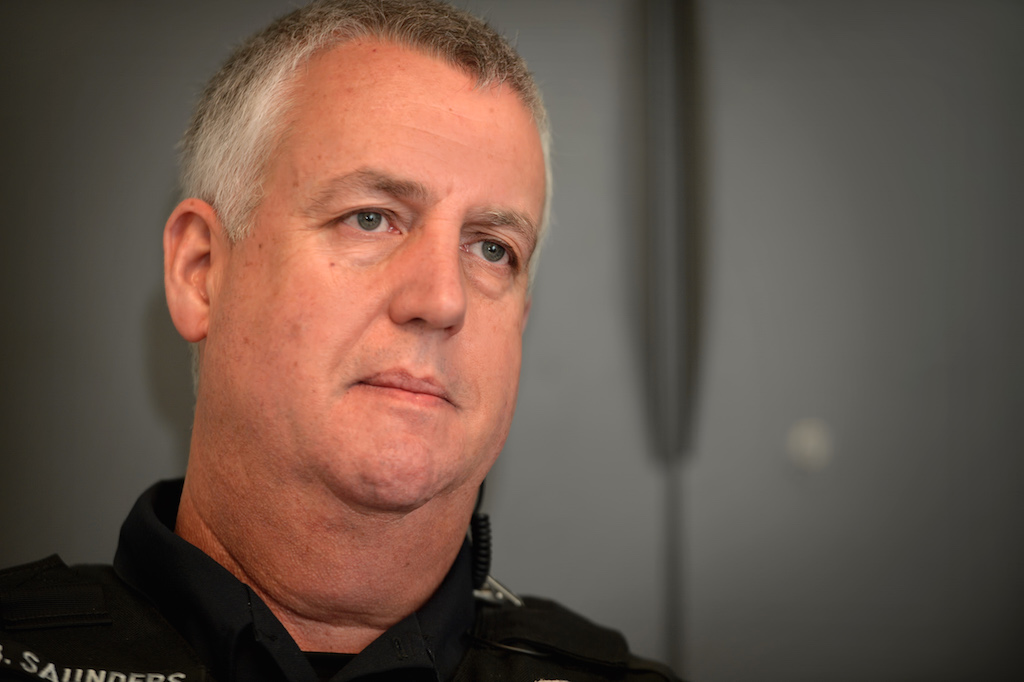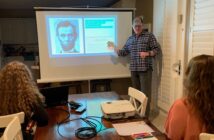He heard it before he saw it.
As Brad Saunders raised his arm to hail a taxicab, the distinct sound of jet engines overhead made him pause.
Planes didn’t fly in the area, and he knew it.
Although based out of Los Angeles, as a manager for the largest global investment firm in the world, Saunders frequently traveled to New York.
His meetings were nearly always held on the 66th floor of 2 World Trade Center where the company was headquartered.
But that morning, Saunders was summoned to a rare offsite meeting in Midtown.
He never went up to the 66th floor.
He grabbed a quick breakfast and a coffee to go, then tried to hail a cab just outside of the north tower at 1 World Trade Center.
When American Airlines Flight 11 flew over his shoulder and square into the north tower behind him, that was the start of what Saunders refers to as his second life — the one that began after Sept. 11, 2001.
LEAVING LAW ENFORCEMENT
A high school aptitude test pointed Saunders to two careers: law enforcement or the military.
Influenced by a Garden Grove school resource officer he got to know during his teen years, Saunders decided to pursue a career in law enforcement.
While serving as an officer for Garden Grove PD, Saunders also worked on getting his finance degree from Cal State Fullerton.
After earning his bachelor’s degree, he went on to obtain his Master’s of Business Administration from Pepperdine University.
Saunders — a left-brain guy with an aptitude for numbers — left Garden Grove PD after 10 years to take a job in finance.
He climbed the ranks quickly at his firm, ultimately becoming a manager of hundreds of employees in eight time zones.
He said he enjoyed working on Wall Street.
On Sept. 11, 2001, Saunders flew to New York for a finance meeting.
As he hailed a cab and watched that American Airlines flight come over the horizon and decimate the north tower above him, his mind raced.
He first thought of his family.
Saunders pulled out his cell phone and called his wife, Andrea.
“Turn on the news, I’m not in the building,” he told her.
His wife, at home in Orange County, rubbed the sleep from her eyes and tried to make sense of what he was telling her.
She could hear yelling in the background.
Andrea turned on the news but didn’t see any coverage at first.
“The first thing I said to him was, ‘Do not go in that building’ — I know my husband,” she said. “He told me to call his parents and said he would call me back.”
People on the street below stood still, their necks craned to the fiery scene hundreds of feet above them.
Fuel, debris and aircraft parts spilled to the ground below as the plane crashed into the building, creating what Saunders said was the longest explosion he has ever heard.
Drivers stopped and turned up their radios, searching for a talk show that might explain what they were seeing.
Was it an accident? Was it a private plane that went off course and crashed? What happened?
Saunders knew it wasn’t an accident.
“In 1993, when the World Trade Center was bombed the first time, our global threat assessment was that we would be attacked by an aircraft,” he said. “It matched what we already knew our threat was.
“Al-Qaeda had already tried to take it out once; it was no surprise when they came back and were successful.”
Seventeen minutes later, United Airlines flight 175 exploded into the south tower.
This time, people didn’t stand still, Saunders said.
“Everyone just started stampeding in the streets,” he said. “It was pandemonium.”
In the chaos at ground level, Saunders lost his phone.
Andrea Saunders tried to reach her husband as the hours passed, but there was no answer.
“When the second plane hit the building, I didn’t know whether he was alive or dead,” she said.
Andrea wanted to keep things normal for their teenage daughter, so she wouldn’t worry about her father or what was happening in the country.
Andrea Saunders dropped her daughter off at school, and then returned home.
Saunders’ family and friends knew he was in New York and, one by one, neighbors started coming to be with Andrea.
Women in their pajamas drank coffee and huddled in front of the television, watching in disbelief as the Twin Towers stood smoldering.
Meanwhile, in New York, Saunders was scanning panicked faces for someone he knew or someone he could help.
“It never dawned on me that the buildings would collapse,” he said. “So I stayed on the north side of the complex.”
Paperwork and furniture littered the streets along with hundreds and hundreds of women’s shoes. Women in New York keep their nice shoes under their desk to change into after walking to work in comfortable sneakers, Saunders said.
He looked up to see people leaping from the buildings to their deaths — a horror that Saunders can’t erase from his mind.
“Most of America never really saw what happened that day,” he said. “That was the hardest thing to watch — people jumping out of the buildings holding hands on the way down, or praying on the way down.”
When the south tower collapsed at 9:59 a.m., a thick cloud of dust and rubble charged through Manhattan streets, covering those on the ground in debris.
“By the grace of God, I was in the right place at the right time,” Saunders said. “If I was not on the north side, I wouldn’t be here today.”
Twenty-nine minutes later, the north tower buckled.
Saunders found cover in the doorway of a nearby building.
When the debris settled, he wandered near the pile of rubble and looked for people he knew until daylight disappeared.
“We spent the rest of the day trying to track down people we knew to make sure everyone was OK,” he said. “And obviously, not everyone was OK.
“People wandered the streets with pictures, crying and asking, ‘Have you seen my husband? Have you seen my daughter?’ There were thousands of people looking for their loved ones, but they were all dead.”
Saunders and his colleagues stayed in a Manhattan hotel and he was finally able to call home and speak to his wife.
Andrea said she remembers that phone call — simultaneous relief and overwhelming grief.
“He just cried and said, ‘We lost them all’,” Andrea recalled.

Tustin PD Officer Bradley Saunders, terrorism liaison officer for the Tustin PD, talks about his 9/11 experience working at the World Trade center in New York the day the plans flew into the Twin Towers.
Photo by Steven Georges/Behind the Badge OC
Saunders was stuck in Manhattan for three days following the attacks.
Flights were grounded, not that anyone would have boarded a commercial jet anyway, and rental car companies were sold out, Saunders said.
Then he remembered an RV lot near Newark Airport.
He called and booked an RV rental on Friday, Sept. 14, and drove home with his three colleagues.
It took them two days to get to Orange County, and when Saunders pulled onto his street, his neighbors were waiting to welcome him home.
“I was grateful that he was OK,” Andrea Saunders said. “It was pure chaos until he came home.”
Nearly 3,000 people were killed in the attacks on the World Trade Center, the Pentagon and Pennsylvania that day, including 13 of Saunders’ friends.
“I wondered, ‘Why am I here and not somebody else?’” he said. “These people did nothing. They just woke up that morning, were having coffee at their desk and somebody murdered them.
“That morning I realized, it just wasn’t about me anymore. My story is irrelevant compared to the stories of 3,000 other families and what happened that day.”
A CALLING TO SERVE
The company Saunders worked for advised those who were in New York on Sept. 11, 2001, to give it 30 days — 30 before making any life-changing decisions.
On day 30, Saunders applied to become an officer with the Tustin Police Department.
“At 40 years old, I never thought I would ever have seen myself in a police uniform again,” he said. “I just said, ‘This is what God intends me to do.’”
Seven months after the attack, in April 2002, Saunders — still trying to get hired as a cop — returned to New York.
“I didn’t feel like I was ready to go back, but I knew I wouldn’t feel settled until they were done recovering the bodies of the people I knew,” he said. “I went out of respect for them.”
As Saunders stood looking into the vast crater where symbols of America’s economic strength and power once stood, his phone rang.
It was the Tustin Police Department offering him a job.
“(Sept. 11) clarified what is important,” Saunders said. “Life is best served in the service of others. I feel the work we do is God’s work, and it has meaning.
“My only choice was to go back in uniform.”
At 40 years old, Saunders was sworn in as a Tustin Police officer.
It felt different than the first time he put on a uniform more than a decade earlier, but he was comfortable.
“I wanted to serve and feel at peace in uniform,” he said. “There’s no place I’d rather be at this time in my life.”
Since joining Tustin PD, Saunders, 54, makes a point to work every Sept. 11 as a show of respect for those who lost their lives that day.
He also attends a local remembrance ceremony, which he said he is disappointed to see dwindle in size with every passing year.
“Hundreds, if not thousands, used to show up at those events, but America has forgotten,” he said. “Some don’t have the luxury of forgetting.”
The City of Tustin will hold a 9-11 remembrance ceremony at 8:30 a.m. Friday at Orange County Fire Authority Station No. 37, 15011 Kensington Park Dr.
 Behind the Badge
Behind the Badge



